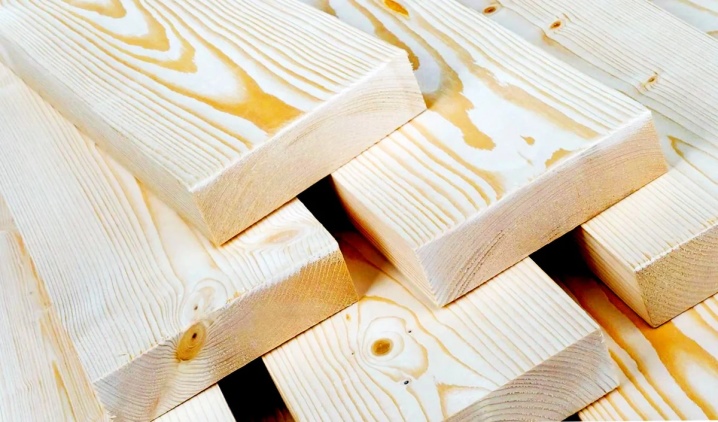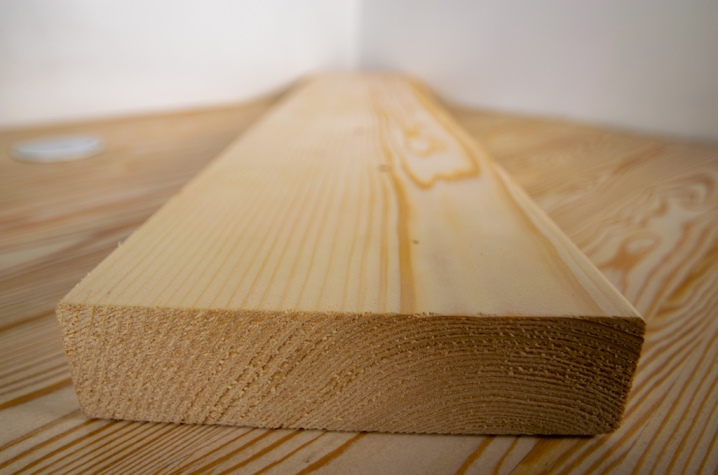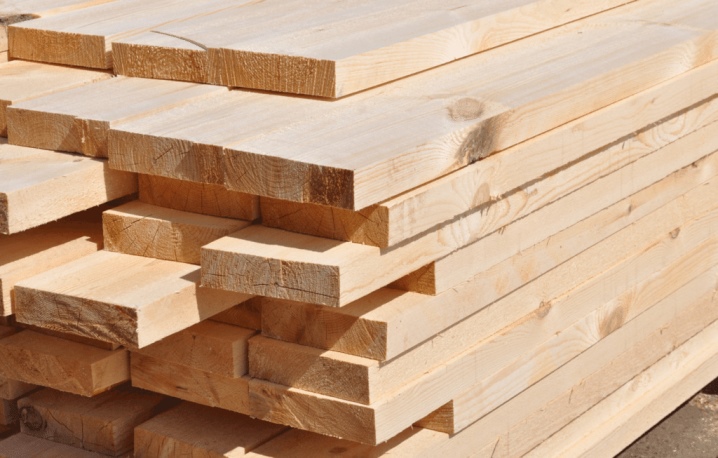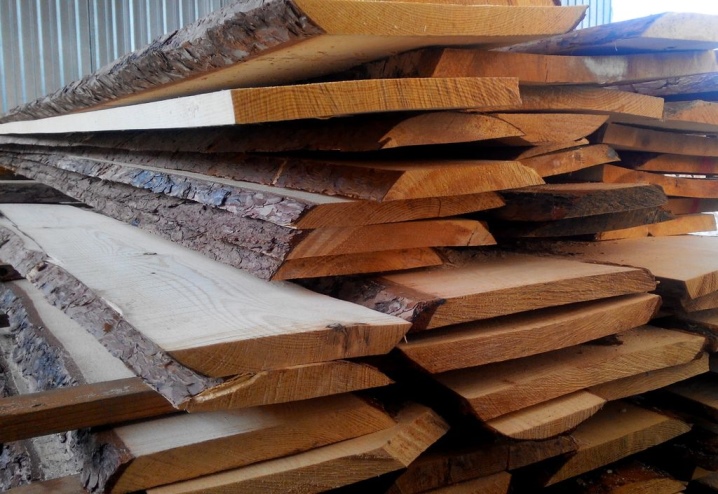All about pine planks

Coniferous lumber is almost always very popular in the construction market. Among the most inexpensive boards of the corresponding class obtained from this group of plant raw materials, pine is considered. At the same time, they are distinguished by their durability and environmental friendliness, so it is very profitable to buy them.

Peculiarities
The pine itself is a huge tree that grows up to 30-40 m in height. Its trunk is very even, in the place of the felling the wood is painted yellow or yellow-red. Due to this color, products from this tree are especially popular.

The wood also has a pleasant coniferous aroma.
Pine board has other advantages:
- acceptable price;
- good level of thermal insulation;
- ease of processing;
- strength - at a high level;
- beautiful and pronounced texture;
- safety for human health.

But pine wood also has disadvantages. First of all, it is the ability to ignite spontaneously under certain conditions. The fact is that pine contains too many resins, which at high temperatures begin to be released too actively. And this, as you know, can lead to fire. However, this shortcoming can be quickly corrected by treating pine lumber with special fire retardants called fire retardants.

Another drawback that cannot be ignored is too large a layer of sapwood (loose part of the wood). When sawing, very often this layer remains on the logs and boards, which contributes to the appearance of various unpleasant defects.
How is it different from other materials?
Distinguishing pine from cedar or spruce is not so difficult.
Its main difference is the striped wood grain. In addition, there are much fewer knots in the pine.
Growth rings are perfectly visible in the incision sites, but the core rays are practically invisible. And also pine is very soft, so it is easy to handle. The tree practically does not crack when dried.

Oak boards are rather difficult to cut, as they have a very strong structure. This circumstance also distinguishes soft pine from hardwood.
Spruce wood has a low density, moreover, it is not as strong as pine. The bark of the tree is light yellow, and its needles are thick and small. Pine needles are much larger and longer. In addition, spruce produces less resin than pine.

Birch wood differs from pine wood: it is white with a reddish or yellow tint. Annual rings are barely visible. Birch is used in a wide variety of industries, for example, for the manufacture of furniture, plywood or veneer.
Aspen is distinguished by its high strength and elasticity. For this reason, it is considered the best material for making beams. Another distinctive feature of aspen is its whiteness. For this reason, boards are often used to decorate ceilings. And also this tree does not emit resins, which makes it possible to use it for the construction of saunas or baths.
Views
Pine boards can be of several types, depending on the processing of their edges.
- Edged. It is a board with edges that have been sawn off perpendicular to the face. Such boards are made on a circular saw or milling machine. Edged boards can be dry, with a moisture content of less than 22%, or wet, with a moisture content of more than 22%.

- Unedged board. This lumber has partially sawn or completely intact edges.Unedged joiner's board differs from ordinary unedged board in that it undergoes technological drying. Therefore, the carpentry material is of a higher quality.

- One-sided edged board. Has one edge sawn off perpendicular to the face.
In addition, the boards differ from each other in the degree of processing.

Sliced boards have smooth (machine-sanded) edges. The non-planed ones do not receive any additional processing.
Pine boards are divided into several varieties.
- Extra grade. Most often, such boards are made for export from Canadian pine. They turn out to be almost perfect, without dry or rotten knots. As for cracks, there should be no more than 11% of the total area. Premium grade boards do not show signs of fungal infections. Quite often, seamless lining is made from such boards.
- 1st grade. Here, 10% of healthy knots and up to 25% of small butt cracks from the entire area are allowed. In addition, the presence of sound spots is possible. They cannot occupy more than 10% of the total area. There should be no traces of rot and disease.
- 2nd grade. Such sawn timber differs from previous varieties in a lower price. Boards may have slight bluish spots. In addition, wane and rotten knots are allowed.
- 3rd grade. Any part of this type of lumber may have a wormhole. The number of rotten knots is allowed 2 times more than that of boards of the 2nd grade. Cracks can be not only deaf, but also through.
- 4th grade. Such boards can be purchased very inexpensively. However, the number of defects is quite large here. The surface of the lumber can be affected by rot, but the total affected area should not exceed 10%. Boards can have a massive wane area.



Dimensions (edit)
GOST 24454-80 defines that pine edged board can have the following parameters:
- width: 75, 100, 150, 200, 250 or 275 mm;
- the thickness of a thin board should be 16, 19 or 22 mm, an average - 25, 32 or 40 mm, and a thick one - 44, 55 or 75 mm;
- the length of the board can be in the range from 1 to 6 meters.


Pine floorboards can be 6.4 to 14 cm wide, 2.1 to 4 cm thick, and 2 to 6 m long. As for the lining, its thickness is in the range of 10-20 mm, the width is in the range of 95-140 mm, and the length is from 1.2 to 5.7 m. The most popular board is 200x20 mm.
Applications
The pine board is very soft and easy to work with. For this reason, it is used in a wide variety of fields of activity. For example, stairs are made of it, roofs are covered, furniture is made.
- Facades. Most often, for finishing facades, boards are used, planed on four sides, which are called facade boards. They are of high quality and beautiful appearance.
Sturdy pine planks are well suited for homes that are located in humid climates.

- Floor. Pine planks are best used for making living room or bedroom floors, as these areas usually do not have large temperature changes and high humidity.
With proper operation, these lumber can serve for a very long time.

In addition, laying the floors is quite simple, because the boards have both a spike and a groove on both sides, so they fit very tightly to each other.
- Furniture. Most often, pine boards are used in the furniture industry. First, all the blanks are subjected to a de-resinification process, and then they are treated with special antiseptics. This allows you to further apply paint or varnish to the product.

Pine furniture looks very elegant and beautiful, so it can fit into any interior of the room.
- Beam and board. Today, the most appreciated building material is pine timber. Manufacturers are trying to process the timber with special means that can increase the service life, as well as protect it from the appearance of rot.
Pine beams or planks can make a wonderful country house. Even a person without special skills can build it.

- Windows and doors. Window and door structures made of pine are characterized by high performance characteristics. They turn out to be quite lightweight, so working with them is convenient and simple. The porous structure of wood allows you to create air exchange between the street and the room inside. Both doors and windows can be of different shapes.

Since the texture of pine is too soft, experts do not recommend using boards from it for the manufacture of doors and windows on the balcony.
Summing up, we can say that pine planks are an excellent building material that can be used in a variety of ways. If done correctly, they will serve their owners for a long time.














The comment was sent successfully.